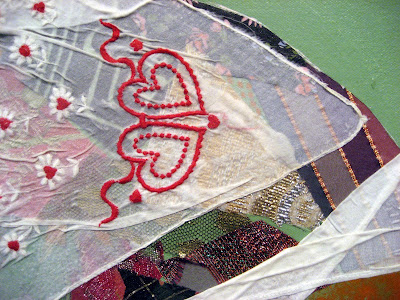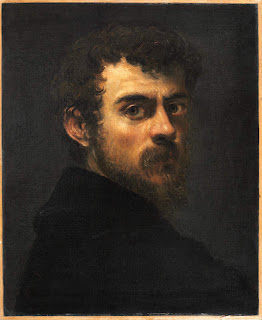 In Daughters of the Revolution (the "Pasted Paper Revolution, " Clement Greenberg's essay description of Cubist collage), the always egalitatian Pavel Zoubok shows 34 artists, many from his gallery's own roster, working with collage. The range is impressive, from such early practitoners of the art as Hannah Hoch and Anne Ryan, to Seventies icons Miriam Schapiro, Hannah Wilke and May Wilson, to contemporary artists like Judy Pfaff, Donna Sharratt and Nora Aslan. Sometimes the work is political and sometimes not; mostly it's on an intimate scale, though there are some impressively large works as well.
In Daughters of the Revolution (the "Pasted Paper Revolution, " Clement Greenberg's essay description of Cubist collage), the always egalitatian Pavel Zoubok shows 34 artists, many from his gallery's own roster, working with collage. The range is impressive, from such early practitoners of the art as Hannah Hoch and Anne Ryan, to Seventies icons Miriam Schapiro, Hannah Wilke and May Wilson, to contemporary artists like Judy Pfaff, Donna Sharratt and Nora Aslan. Sometimes the work is political and sometimes not; mostly it's on an intimate scale, though there are some impressively large works as well. 

Miriam Schapiro, My Nosegays Are For Captives, 1976, collage and acrylic on canvas, app. 43 x 34 inches, image from the gallery website; my detail below

Hannah Wilke (1940-1993), Kobenhavn, 1975, kneaded erasers and postcard on painted wood panel, 16 x 18 inches, image from the gallery website; my detail below

.
"This generally intimate art form has historically been more accessible to women, who for many years were excluded from a conventional studio practice; collage was the medium that could be done 'on the kitchen table,'” writes Zoubok in the catalog introduction to a conversation between himself and the painter Melissa Meyer. Meyer, who collaborated with Miriam Schapiro on the 1978 essay Waste Not, Want Not: An Inquiry Into What Women Saved and Assembled—Femmage, underscores the truth of that statement, even among women artists in the 20th Century: "I remember thinking . . . of Lee Krasner getting the kitchen table to work on while Jackson Pollock got the studio."
Daughters of the Revolution: Women and Collage is a big show in a small space. And the installation is a collage in itself. Take a look:
Installation view, from the front of the gallery looking toward the back. The images that follow are on the right-hand wall

India Evans, Into the Selves, 2008, mixed-media collage on paper, 22 x 30 inches; image from the gallery website

Louise Nevelson (1899-1988), Untitled, 1983, mixed-media collage, app. 30 x 20 inches; image from the gallery website



Another view of the installation wall with three by Judy Pfaff, just to the right of the large works in red (the top work there is Strawberries by Ann Shostrom)
Below: Judy Pfaff, Untitled #33, 2007, ink, found images, acrylic paint, perforated and layered paper, app 14 x 18 inches framed; image from the gallery website


Stepping back and looking over Pavel Zoubok's shoulder to the left back wall, you can just make out a work by Donna Sharrett. It's shown below, along with the rest of the work from that corner


Top left: Dodi Wexler, It's Nice to Share Your Home, 2005, mixed media, app. 16 x 28 x 1 inches; Bottom left: Gail Skudera, Veiled Intruder, 1997, mixed-media collage, app. 22 x 20 inches
Center: Nora Aslan, Good Old Games Last Forever, 2008, mixed media collage, 68 x 60 inches; top right, another by Donna Sharrett; bottom right, Miriam Schapiro's My Nosegays are for Captives
Below: Sharrett and Schapiro with Charmion von Wiegand (1896-1893), #154, 1965, mixed-media collage on canvas
In the catalog essay, Zoubok asks Meyer: What do you think has changed with regard to the general attitude toward collage and so-called 'women's work'?
Meyer: My take on the art world in 1978 is that it was not interested in supporting "women's art" and giving women credit for predating anything aesthetically in the canon—but this is now 31 years later, and a lot has changed.
Still, if MoMA put on a collage show whom would it feature? Braque, Cornell, Gris, Picasso, Shwitters, Samaras, Rauschenberg and Rotella, I'd wager. Sons of the Establishment. So Daughters of the Revolution is not only a great exhibition, it's a historically important exhibition. A catalog is available at the gallery ($10) or by mail ($12). Contact the gallery for mail-order specifics.
Daughters of the Revolution: Women and Collage at Pavel Zoubok, at 533 W. 23rd Street, is up through August 14. Summer hours (Mon-Fri) are in effect.
(Next Wednesday, August 6, I'll post Part 2: The Female Gaze: Women Look at Women at Cheim & Read.)
.



























































